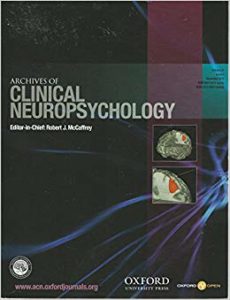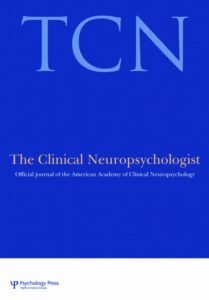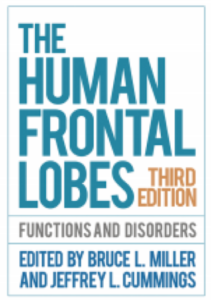DR. ANNETTE ERMSHAR
PEER REVIEWED RESEARCH PUBLICATIONS
Wait, there’s a baby in this bath water! Update on quantitative and qualitative cut-offs for Rey 15-item Recall and Recognition
Poynter, K., Boone, K. B., Ermshar, E., Miora, D., Cottingham, M., Victor, T. L., Ziegler, E., Zeller, M., & Wright, M.
Archives of Clinical Neuropsychology. Epub ahead of print.
November 3, 2018
ABSTRACT
Objective: Evaluate the effectiveness of Rey 15-item plus recognition data in a large neuropsychological sample. Method: Rey 15-item plus recognition scores were compared in credible (n = 138) and noncredible (n = 353) neuropsychology referrals. Results: Noncredible patients scored significantly worse than credible patients on all Rey 15-item plus recognition scores. When cut-offs were selected to maintain at least 89.9% specificity, cut-offs could be made more stringent, with the highest sensitivity found for recognition correct (cut-off ≤11; 62.6% sensitivity) and the combination score (recall + recognition – false positives; cut-off ≤22; 60.6% sensitivity), followed by recall correct (cut-off ≤11; 49.3% sensitivity), and recognition false positive errors (≥3; 17.9% sensitivity). A cut-off of ≥4 applied to a summed qualitative error score for the recall trial resulted in 19.4% sensitivity. Approximately 10% of credible subjects failed either recall correct or recognition correct, whereas two-thirds of noncredible patients (67.7%) showed this pattern. Thirteen percent of credible patients failed either recall correct, recognition correct, or the recall qualitative error score, whereas nearly 70% of noncredible patients failed at least one of the three. Some individual qualitative recognition errors had low false positive rates (<2%) indicating that their presence was virtually pathognomonic for noncredible performance. Older age (>50) and IQ < 80 were associated with increased false positive rates in credible patients. Conclusions: Data on a larger sample than that available in the 2002 validation study show that Rey 15-item plus recognition cut-offs can be made more stringent, and thereby detect up to 70% of noncredible test takers, but the test should be used cautiously in older individuals and in individuals with lowered IQ.

Cross-validation of the Dot Counting Test in a large sample of credible and non-credible patients referred for neuropsychological testing
Courtney McCaul, Kyle B. Boone, Annette Ermshar, Maria Cottingham, Tara L. Victor, Elizabeth Ziegler, Michelle A. Zeller & Matthew Wright
The Clinical Neuropsychologist, Volume 32 Issue 6, Pages 1054-1067
January 18, 2018
ABSTRACT
Objective: To cross-validate the Dot Counting Test in a large neuropsychological sample. Method: Dot Counting Test scores were compared in credible (n = 142) and non-credible (n = 335) neuropsychology referrals. Results: Non-credible patients scored significantly higher than credible patients on all Dot Counting Test scores. While the original E-score cut-off of ≥17 achieved excellent specificity (96.5%), it was associated with mediocre sensitivity (52.8%). However, the cut-off could be substantially lowered to ≥13.80, while still maintaining adequate specificity (≥90%), and raising sensitivity to 70.0%. Examination of non-credible subgroups revealed that Dot Counting Test sensitivity in feigned mild traumatic brain injury (mTBI) was 55.8%, whereas sensitivity was 90.6% in patients with non-credible cognitive dysfunction in the context of claimed psychosis, and 81.0% in patients with non-credible cognitive performance in depression or severe TBI. Thus, the Dot Counting Test may have a particular role in detection of non-credible cognitive symptoms in claimed psychiatric disorders. Alternative to use of the E-score, failure on ≥1 cut-offs applied to individual Dot Counting Test scores (≥6.0″ for mean grouped dot counting time, ≥10.0″ for mean ungrouped dot counting time, and ≥4 errors), occurred in 11.3% of the credible sample, while nearly two-thirds (63.6%) of the non-credible sample failed one of more of these cut-offs. Conclusions: An E-score cut-off of 13.80, or failure on ≥1 individual score cut-offs, resulted in few false positive identifications in credible patients, and achieved high sensitivity (64.0–70.0%), and therefore appear appropriate for use in identifying neurocognitive performance invalidity.

The Role of the Frontal Lobes in Antisocial and Aggressive Behavior: Review of the Research and Legal Implications
Annette L. Ermshar & Kyle Brauer Boone
The Human Frontal Lobes, Third Edition, IV. Neuropsychiatric Disorders
December 12, 2017
EXCERPT
Criminal, violent and homicidal behaviors have etiological links to biological, psychological and sociological factors. Death row statistics suggest that inmates have histories of the following risk factors: intellectual deficiency; low commitment to school/poor academic success; head injury, neurological injury, and organic brain impairment; neuropsychological and cognitive deficits; psychiatric disorders (e.g. schizophrenia and affective disorders); history of family abuse and/or neglect; parental substance abuse; family separation; and a history of substance dependence (Fabian, 2010, p.210).
Thus multiple biopsychosocial risk factors increase a likelihood of violence (Gilchrist, Radcliffe, Noto & d’Oliveira, 2 017; Schaefer & Hennessy, 2001), and organic neuropathology and neuropsychological impairment have unique cumulative effects on an individual’s behavior and potential for violence (Fabian, 2010; Parrott, Swartout, Echkardt, & Subramani, 2017) Furthermore, as summarized below (with an emphasis on literature published primarily within the past 20 years), frontal lobe substrates have been found to be intimately tied to criminal behavior in general and impulsive violence in particular.

Examination of the Modified Somatic Perception Questionnaire (MSPQ) in a large sample of credible and noncredible patients referred for neuropsychological testing
Mariam Balasanyan, Kyle B. Boone, Annette Ermshar, Deborah Miora, Maria Cottingham, Tara L. Victor, Elizabeth Ziegler, Michelle A. Zeller & Matthew Wright
The Clinical Neuropsychologist, Volume 32, Issue 1, Pages 165-182
June 6, 2017
ABSTRACT
Objective: The current study evaluated MSPQ sensitivity to noncredible PVT performance in the context of external incentive, and examined MSPQ false positive rates in noncompensation-seeking neuropsychology patients; and investigated effects of ethnicity/culture, gender, and somatoform diagnosis on MSPQ scores, and relationships with PVT and MMPI-2-RF data. Method: MSPQ scores were compared in credible (n = 110) and noncredible (n = 153) neuropsychology referrals. Results: Noncredible patients scored higher than credible patients. When the credible group was divided into those with somatoform orientation (n = 39) versus those without (n = 71), the credible nonsomatoform group scored lower than the other two groups, who did not differ from each other. MSPQ elevations were found in ethnic minorities, and in individuals who learned English as a second language or concurrently with another language. MSPQ elevations were also associated with chronic systemic diseases, neurologic illness, and substance abuse. Women scored higher than men, but men and women were equally represented among those patients scoring beyond cut-offs. MSPQ scores were minimally related to PVT data but were more strongly correlated with MMPI-2-RF scales, particularly over-report validity scales, RC1, and Somatic/Cognitive scales, with more widespread relationships observed in noncredible patients. Conclusions: A cut-off of 18 resulted in few false positives in credible nonsomatoform patients, and appears appropriate for identifying physical symptom over-report (due to malingering or somatoform orientations), with associated sensitivity of 29%. However, clinicians are cautioned regarding using the MSPQ in patients with systemic, neurologic, and substance abuse conditions, and in ethnic minorities and non-monolingual English-speakers.

Forensic Psychology: Preparing Female Clinicians for Challenging Offenders
Annette L. Ermshar & Adrienne M. Meier
Women & Therapy, Volume 37, Issue 1-2, 2014
February 24, 2014
ABSTRACT
Preparing female clinicians for the emotional and psychological demands of forensic work with violent and/or sexual offenders is imperative. Stereotypical gender scripts, such as the expectation that females must empathize with victims, result in stigmatization of female clinicians. Biases that women are less capable of handling such offenders contribute to increased difficulties within the field. Preparing female trainees for counter transferential issues, de-feminization, and the potential for vicarious traumatization will serve to help female clinicians continue to thrive in the field of forensic evaluation and treatment; thereby benefitting treatment and the field in general.

Stalking as paranoid attachment: A typological and dynamic model
John S. Wilson, PhD, Annette L. Ermshar & Robert K. Welsh
Attachment & Human Development, Volume 8 Issue 2
2006
ABSTRACT
Stalking encompasses a wide range of behavioral patterns, risk factors, interpersonal dynamics, and dangerousness. To account for these diverse phenomena, we propose that stalking behavior is best conceptualized by a dynamic interaction of attachment styles and psychodynamic phenomena. This paper articulates a model that explains stalking behavior within the framework of attachment theory. Four prototypical configurations of stalkers and their victims are developed. Each configuration is discussed in terms of a pattern of internal representations, affective constellations, combinations of aggression and narcissism, and potential for future violence. The four configurations proposed here are maintained through stalkers’ over ideational linkage fantasies and projective identifications, which range from shame-prone and needy idealization to malevolent torment of the victim. Our model arrays erotomanic, jealous, and persecutory attachments along a continuum of increasingly paranoid and pathological identifications. We argue that these prototypical attachment configurations provide a theoretically driven means of differentiating phases of stalking, and as such provide useful leads in the empirical study and clinical assessment, treatment, and management of stalkers.

PUBLISHED ABSTRACTS
Warner-Chacon, K., Ermshar, A., & Glassmire, D.M. (2001). Psychopathy and Abstract Concept Formation among forensic psychiatric patients [Abstract]. Archives of Clinical Neuropsychology, 16(8).
PEER REVIEWED RESEARCH CONFERENCE PRESENTATIONS
Sammons, M.T., Ermshar, A., Lincoln, A., & Skuja, A. “Ethical, Legal, and Practice Implication of Recent Developments in Psychopharmacology for Psychologists.” Panel Presentation at the California Psychological Association annual conference, San Diego, CA, April 26, 2015
Feuer, B.S., Ermshar, A. “Effects of Cyberstalking Severity, Gender, and the Victim-Perpetrator Relationship on Reporting to Law Enforcement.†Poster Presentation at the California Psychological Association annual conference, San Diego, CA, April 25, 2015
Poynter, K., Boone, K., Cottingham, M. E., Ermshar, A., Miora, D., Victor, T., Ziegler, E., & Zeller, M. “A Re-examination of the Rey 15-item plus Recognition Test: There’s a baby in that bath water!†Poster presentation at the American Academy of Clinical Neuropsychology annual conference, NYC, June 25-28, 2014.
Sobel, N., Boone, K., Cottingham, M., Ermshar, A., & Miora, D. (2013, March). Bridging the Gap Between Test Versions: WAIS-III/IV Matrix Reasoning as an Embedded Symptom Validity Indicator. Paper presentation at the American Law and Psychology Society Conference, Portland, Oregon.
Lance, D., Ermshar, A., Boone, K., & Miora, D. (2012, April). Evaluating Executive Functioning in Individuals with Bipolar Spectrum Disorders Utilizing Selected Subtests from the D-KEFS. Poster presented at the California Psychological Association Conference, Monterey, California.
Tross, R., Ermshar, A., Miora, D., & Dixon, D. (2012, March). Perspectives on the value and effectiveness of registry and notification laws with juvenile sex offenders. Poster presented at the American Law and Psychology Society Conference, San Juan, Puerto Rico.
Chan, W., Hung, J.M., Ermshar, A., Welsh, R.K., & Reimer, K.S. (2011, August). Factor structure of the PCL-R in a multiethnic sample of insanity acquittees. Poster presented at the Annual Convention of the American Psychological Association, Washington, DC.
Jacoubs-Beye, J., Chou, A. Reimer, K.S., Welsh, R., Ermshar, A., & Alfano, K. (2011, August). Factor structure of the Psychopathy Checklist-Revised with female insanity acquittees. Poster presented at the Annual Convention of the American Psychological Association, Washington, DC.
Chan, W., Jacoubs-Beye, J., Alfano, K., Ermshar, A., Welsh, R., Stevenson, L., Vindua, K., Edmunson, N., Ziebell, J. & Huntsinger, K. Normative Data on Measures of Executive Functioning in Insanity Acquittees. Paper presented to the 2007 American Psychological Association Annual Convention, Division 41, San Francisco.
Stevenson, L., Vindua, K., Ermshar, A., Welsh, R., Chan, W., Jacoubs, J., Holler, R., Edmunson, N., Alfano, K., Huntsinger, K., & Ziebel, J. Psychopathy and the Homicidal Triad in Insanity Acquittees. Paper presented to the 2007 American Psychological Association Annual Convention, Division 41, San Francisco
Jacoubs-Beye, J., Welsh, R., Ermshar, A., & Reimer, K. (August, 2006). Factor Structure of the PCL-R on Female Insanity Acquitees. Paper presented at the 2006 Annual Convention of the American Psychological Association. New Orleans, Louisiana.
De La Rosa, H., Chan, J., Kuehfuss, K., Krishnamurthy,V., Macias, A., Snay, R., Pivonka, J., Ermshar, A., Freier, M.C. (August, 2003) Perceptions of parenting children with VCFS: A comparison study. Oral presentation at the 2003 Annual International VCFSEF Conference,
Proctor, G., & Ermshar, A. (March, 2003). Doctor, if only I’d known…Informed Consent as a Risk Management Tool. Presented at the 71st Annual Postgraduate Convention, Loma Linda University, School of Medicine.
Warner-Chacon, K., Ermshar, A., & Glassmire, D. (October, 2001). Abstract Concept Formation and Psychopathy in Forensic Psychiatric Inpatients. Paper presented at the 21st annual conference of the National Academy of Neurospychology. San Francisco, California.
Ermshar, A.L., Miller-Perrin, C., & McAdam, N. (August, 2001). Perceptions of Sexual Development and Interpersonal Intimacy. Paper presented at the 2001 annual convention of the American Psychological Association. San Francisco, California.
Ermshar, A.L., Freier, K., D’Antonio, L., Sonne, J., Riggs, M., Mallery, S., & Flora-Tostada, J. (August, 2001). Velocardiofacial Syndrome in Children: Early Emotional and Behavioral Development. Paper presented at the 109th annual convention of the American Psychological Association. San Francisco
Freier, M.C., Freeman, K.R., D’Antonio, L., Ermshar, A.L., & Vaz, C. (June, 2000). Cognitive Development and Behavioral Manifestations in Children with Velocardiofacial Syndrome. Paper presented at the annual Pediatrics meeting, Bringing the 22q11.2 Deletion Into the 21st Century, Philadelphia, PA
Sonne, J.L., Borys, D.S., Haviland, M.G., & Ermshar, A.L. (1998). Subsequent therapists’ reports on the effects of nonsexual multiple relationships on psychotherapy patients: An exploratory study. Paper presented at the meeting of the California Psychological Society, Pasadena, California.
Anger, S, Ermshar, A.L., & Miller-Perrin, C.L. (1994). Long Term Effects of Sexual Abuse in Childhood: Sexual and Social Development. Paper presented at the 102nd annual convention of the American Psychological Association. Los Angeles, California.
Ermshar, A.L., & Miller-Perrin, C.L. (1994). Sexual Development, Attitudes and Functioning of Child Sexual Abuse Survivors. Paper presented at the Third Annual University of California, Los Angeles Psychology Undergraduate Research Conference. Los Angeles, California.